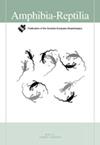非洲爪蟾水下鸣叫和觅食活动的量化
IF 1.3
4区 生物学
Q3 ZOOLOGY
引用次数: 1
摘要
水生无尾猿物种难以探测和观察,这是对其行为和生态学研究的主要限制。这种习性限制了对性和觅食活动的直接监测,也限制了对环境因素如何影响它们的表达以及个体如何在竞争活动之间分配时间的调查。我们在非洲爪蟾(Xenopus laevis)中研究了这个问题,这是一种主要在水中觅食并在水下发出叫声的青蛙。这种生物学模式物种已经在实验室中进行了广泛的研究,但其在自然界中的行为仍然缺乏描述。我们在法国入侵范围的繁殖季节在一个池塘进行了一项研究。我们使用水听器记录了水下声音活动作为性活动的代理,设置了食物诱饵陷阱来量化觅食活动,并记录了两个月球周期内的环境条件(月光强度、温度和降雨量)。我们发现个体在繁殖季节会进行这两种活动。在繁殖高峰期,发声活动在白天表达。在繁殖(鸣叫活动)上的投资可能会减少分配给觅食的时间。这两种活动似乎是根据月光强度分开的,对男性的影响更大。当月光强度增加时,觅食活动减少,发声活动增加。我们还观察到温度对声音活动的负面影响和降雨对声音活动的积极影响。我们的方法有望监测其他水生无尾目动物的活动。本文章由计算机程序翻译,如有差异,请以英文原文为准。
Quantification of underwater calling and foraging activities in the African clawed frog Xenopus laevis
Aquatic anuran species are difficult to detect and observe and this is a major limit to the study of their behaviour and ecology. This habit limits the direct monitoring of sexual and foraging activity, and the investigation of how environmental factors influence their expression as well as how individuals allocate time between competing activities. We investigated this issue in Xenopus laevis, a mostly aquatic frog that forages and emits calls underwater. This model species in biology has been extensively studied in the lab but its behaviour in nature remains poorly described. We carried out a study in a pond during the breeding season in the French invasive range. We recorded underwater vocal activity as a proxy for sexual activity using a hydrophone, set food-baited traps to quantify foraging activity, and recorded environmental conditions (moonlight intensity, temperature and rainfall) over two lunar cycles. We found that individuals engage in these two activities during the breeding season. At the peak of the breeding period, vocal activity was expressed during the day. The investment in reproduction (calling activity) may reduce the time allocated to foraging on a circadian scale. The two activities seem to be partitioned depending on moonlight intensity, with a stronger effect on males. Foraging activity decreased and vocal activity increased when moonlight intensity increased. We also observed a negative effect of temperature and a positive effect of rainfall on vocal activity only. Our method is promising to monitor the activity of other aquatic anurans.
求助全文
通过发布文献求助,成功后即可免费获取论文全文。
去求助
来源期刊

Amphibia-Reptilia
生物-动物学
CiteScore
3.10
自引率
6.20%
发文量
39
审稿时长
6-12 weeks
期刊介绍:
Amphibia-Reptilia is a leading European multi-disciplinary journal devoted to most of the aspects of herpetology: ecology, behaviour, evolution, conservation, physiology, morphology, paleontology, genetics, and systematics.
Amphibia-Reptilia publishes high quality original papers, short-notes, reviews, book reviews and news of the Societas Europaea Herpetologica (SEH). The Societas Europaea Herpteologica (SEH) website is located at: www.seh-herpetology.org.
 求助内容:
求助内容: 应助结果提醒方式:
应助结果提醒方式:


